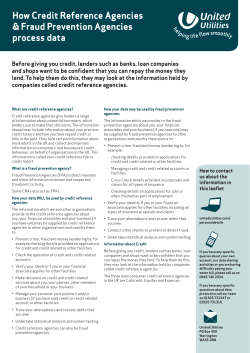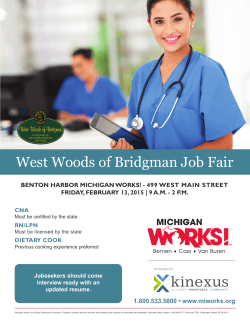
Discussion Developing a Food Fraud Prevention Program
Developing a Food Fraud Prevention Program - Assessing Food Fraud vulnerabilities and how to develop Food Fraud prevention strategies Douglas C. Moyer, PhD, CPP Food Fraud Initiative Michigan State University @Douglas_Moyer @FoodFraud moyerdo1@msu.edu www.FoodFraud.MSU.edu * Presentation Agenda • • • • • • • • • • • MSU Food Fraud Curriculum Definition of Food Fraud Food Protection Matrix Food Safety Management System Multidisciplinary Approach Fraud and Fraudster Typologies Cluster Analysis Tool Food Fraud Prevention System Public Private Partnerships Acknowledgements Discussion © 2015 Michigan State University Presentation PDF at: www.FoodFraud.msu.edu 2 Food Fraud Curriculum Massive Open Online Course (MOOC – free, open, online) • • May 19 & 26; November 2 & 6 Bi-Lingual English-Mandarin Free, open, online, open to everyone, includes a ‘certificate of completion’ www.FoodFraud.msu.edu Executive Education (Short-Course) • • Food Fraud, Quantifying Food Risk with Vulnerably Assessments June 15-16/ 17-18; September 21-22/ 23-24 Graduate Courses (Online, Three Credits) • • • • • Anti-Counterfeit & Product Protection (Food Fraud) Quantifying Food Risk (including Food Fraud) Global Food Safety (including Food Fraud) Food Protection and Defense (Packaging Module) Packaging for Food Safety Graduate Certificate (Online, Four Courses Each) • Certificate in Food Fraud Prevention (Food Safety) Master of Science in Food Safety (Online) • www.online.FoodSafety.msu.edu © 2015 Michigan State University 3 What is Food Fraud? Food fraud is a collective term used to encompass… • the deliberate and intentional… • substitution, addition, tampering, or misrepresentation of… • food, food ingredients, or food packaging; • or false or misleading statements made about a product, • for economic gain. Spink, John, & Moyer, Douglas C. (2011). Defining the Public Health Threat of Food Fraud. Journal of Food Science, 76(9), R157-162. © 2015 Michigan State University 4 Food Protection Matrix Food Security The Cause leading to the Effect of Adultera&on Preven#on is understanding the mo#va#on Food Fraud(1) Mo#va#on Gain: Economic Food Safety Food Defense Harm: Public Health, Economic, or Terror Uninten&onal Inten&onal Food Quality Ac#on Source: Adapted from: Spink (2006), The Counterfeit Food and Beverage Threat, Associa&on of Food and Drug Officials (AFDO), Annual Mee&ng 2006; Spink, J. & Moyer, DC (2011) Defining the Public Health Threat of Food Fraud, Journal of Food Science, November 2015 © 2015 Michigan State University 5 © 2015 Michigan State University 6 Multidisciplinary Approach to Food Fraud • Food Science • Crime Science (Criminology) • Packaging Science • Supply Chain Management (Logistics) • Business Decision-Sciences and Enterprise Risk Management © 2015 Michigan State University 7 Types of Food Fraud Term Definition Example Adulteration A component of the finished product is fraudulent Melamine added to milk Tampering Legitimate product and packaging are used in a fraudulent way Changed expiry information, product up-labeling, etc. Over-run Legitimate product is made in excess of production agreements Under-reporting of production Theft Legitimate product is stolen and passed off as legitimately procured Diversion The sale or distribution of legitimate products outside of intended markets Simulation Illegitimate product is designed to look like but not exactly copy the legitimate product Stolen products are comingled with legitimate products. Relief food redirected to markets where aid is not required “Knock-offs” of popular foods not produced with same food safety assurances Copies of popular foods not produced with same food safety assurances Counterfeiting Intellectual Property Rights infringement, which could include all aspects of the fraudulent product and packaging being fully replicated © 2015 Michigan State University 8 Types of Counterfeiter Criminals • Recreational • Occasional • Occupational (Employee) • Professional • Ideological (Spink, Adapta&on from Haskins, 2003 and Lockhart, 1996) © 2015 Michigan State University 9 Food Fraud Cluster Analysis Tool Spink & Moyer, Development of a Product Counterfeiting Incident Cluster Tool, Crime Science 2014, 3:3 © 2015 Michigan State University 10 Incident Clustering: Top-Down Estimate • A top-down, qualitative estimate of the types of fraud, fraudsters, and offender organizations. • More detailed assessments include actual incident data (i.e. internal confidential and external public sources). Type of Counterfeiter Type of counterfeiting Type of offense Recreational Occasional Occupational Adulteration x Substitution x Tampering x Over-run x Theft x x x x Diversion x Simulation Type of offender Professional x x Counterfeiting (IPR) x Individual/Small groups x x General criminal enterprise x Organized crime members x © 2015 Michigan State University 11 11 Food Fraud Prevention System Incidents Enterprise Risk Management Horizon Scanning Manage: Vulnerability Assessment Detect Deter Adulterants Tampering Theft Over-runs Diversion Counterfeits Prevent Countermeasures © 2015 Michigan State University 12 Public Private Partnership • Interpol/ Europol & GFSI http://www.interpol.int/Crime-areas/Trafficking-in-illicit-goodsand-counterfeiting/Operations/Operations/Operation-Opson-II © 2015 Michigan State University 13 © 2015 Michigan State University 14 Acknowledgements • • • • • • • • • • • • • • • • • MSU Veterinary Medicine: Dr. John Spink, Dean Christopher Brown, Chair Dan Grooms, Chair Ray Geor, Dr. Wilson Rumbeiha, Cindy Wilson, Dean John Baker MSU Global: Associate Provost/ Executive Director Christine Geith, Jerry Rhead, Gwyn Shelle, Lauren Zavala, Associate Provost/ EVP Dr. Karen Klomparens, Rashad Muhammad Queens’s University Belfast (UK): Professor & Director Christopher Elliott, Dr. Moira Dean, Dr. Michael Hollis MSU Online Master’s of Science in Food Safety: Director Melinda Wilkins, Ex-Director Julie Funk, Kristi Denbrock, Heather Ricks, Peggy Trommater, Heidi Chen, Dr. Gary Ades, Chair Ray Goer MSU Food Science: Chair Fred Derksen, Les Bourquin, Bradley Marks, Felicia Wu, VP of Research Ian Gray, David Ortega, Gale Strasburg MSU Program in Public Health: Director Michael Rip MSU NFSTC: Dr. Scott Winterstein, Trent Wakenight,, Dr. Kevin Walker, Sandy Enness, Jen Sysak, Dr. Rick Foster, to name a few critical contributors and supporters. MSU Food Safety Policy Center: Dr. Ewen Todd MSU School of Packaging: Dr. Bruce Harte, Dr. Robb Clarke, Dr. Laura Bix, Dr. Paul Singh, Dr. Diana Twede, Dr. Gary Burgess, Dr. Harold Hughes, Dr. Mark Uebersax, Dennis Young, MSU Communication Arts/ Consumer Behavior: Dr. Maria Lapinski and Dr. Nora Rifon MSU Criminal Justice: Dr. Jeremy Wilson, Director Ed McGarrell, Dr. Justin Heinonen, Roy Fenoff, Zoltan Fejas, Barbara Sayre, and Sara Heeg MSU Supply Chain Management: Dr. Cheryl Speier, Dr. Ken Boyer, Dr. John MacDonald, Chair David Closs, Dr. Stan Griffis, Dr. Judy Whipple MSU College Social Science: Dean Marietta Baba and Assoc Dean Chris Maxwell MSU College of Law: Dr. Neil Fortin and Dr. Peter Yu MSU Libraries: Anita Ezzo, Nancy Lucas, Kara Gust MSU International Programs: Dr. Mary Anne Walker, Dr. John Whimms State of Michigan’s Ag & Food Protection Strategy Steering Committee: Dr. John Tilden, Brad Deacon, Gerald Wojtala, Byron Beerbower © 2015 Michigan State University 15 Discussion Developing a Food Fraud Prevention Program - Assessing Food Fraud vulnerabilities and how to develop Food Fraud prevention strategies @Douglas_Moyer @FoodFraud moyerdo1@msu.edu www.FoodFraud.MSU.edu *
© Copyright 2025









